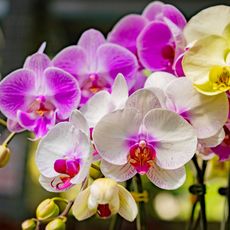Moon Cactus Repotting: When Should Moon Cactus Be Repotted


Moon cacti make popular houseplants. They are the result of grafting two different plants to achieve the colorful top part, which is due to a mutation in that grafted part. When should moon cactus be repotted? Spring is the best time for repotting moon cactus, although the cactus prefers to be rather crowded and doesn’t require a new container more than every few years. New soil, however, is beneficial, as the old soil will lose nutrients and texture over time.
Should Moon Cactus be Repotted?
Most moon cactus plants are the result of grafting Gymnocalycium mihanovichii to a base of Hylocereus. The Hylocereus is a chlorophyll producing plant while the Gymnocalycium does not produce its own chlorophyll and requires the assistance of the Hylocereus to produce food. These tiny cacti do not require repotting very frequently, but you should know when and how to repot moon cactus at least every three to four years.
Cactus plants generally grow in inhospitable terrain with low fertility soil and rocky medium. They can wedge themselves into cracks and crevices with little wiggle room for roots and seem to like it that way. Similarly, a potted cactus enjoys some crowding and only needs an inch (2.5 cm.) or so between itself and the container edge.
The usual reason for moon cactus repotting is to change the soil. If the plant needs a new container, it will begin to show roots out of the drainage holes. This is a sign that a new, slightly larger container is required to allow the plant to grow further. Choose containers that drain well and are not glazed. This is to allow any excess moisture to evaporate, an important consideration in cactus care.
How to Repot a Moon Cactus
As mentioned, spring is the best time to repot cactus. This is because they are actively beginning to grow and root development is starting back up, which leads to a successful transplant. Once you have your container for repotting moon cactus, it is time to turn your attention to the new soil.
A general cactus mix is sufficient, but many growers have better success when they create their own moon cactus potting mix. Equal parts of a peat-based potting soil mixed with coarse sand makes an excellent and well-draining medium. Many gardeners also add some fine gravel to the bottom of the container to enhance drainage. Fill the container halfway with your moon cactus potting mixture and lightly moisten it.
A couple of days before repotting your cactus, water it well so the roots are moistened. Use gloves if you are worried about the little plant's spines and carefully remove it from its container. Insert the plant at the same level at which it was growing and gently pack more of the medium around the roots.
Gardening tips, videos, info and more delivered right to your inbox!
Sign up for the Gardening Know How newsletter today and receive a free download of our most popular eBook "How to Grow Delicious Tomatoes."
Leave enough room at the top of the container so water doesn't spill over. Add a thin layer of gravel or sand as a mulch to the top of the container. Wait a week before watering the newly planted cactus.
Water the cactus when the top inch (2.5 cm.) of soil is dry during the growing season but only once every two or three weeks in winter. Apply fertilizer in spring, such as a 5-10-10 every two to three months, and suspend fertilizing in winter when the plant is not actively growing.

Bonnie Grant is a professional landscaper with a Certification in Urban Gardening. She has been gardening and writing for 15 years. A former professional chef, she has a passion for edible landscaping.
-
 Chamomile In Containers: Growing Chamomile In Pots
Chamomile In Containers: Growing Chamomile In PotsBy Mary Ellen Ellis
-
 How Long Do Orchids Live? And How To Extend Their Lifespan
How Long Do Orchids Live? And How To Extend Their LifespanWhen well cared for, orchids can prove a long-term investment. Discover the lifespan of popular species, and how to prolong your enjoyment of your plant.
By Mary Ellen Ellis
